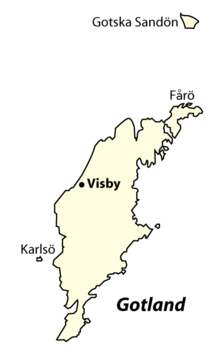| Revision as of 18:27, 20 March 2005 edit196.39.65.57 (talk)No edit summary← Previous edit | Revision as of 10:21, 8 April 2005 edit undo85.74.16.10 (talk)No edit summaryNext edit → | ||
| Line 11: | Line 11: | ||
| *], or ''Gotlands län'' - a current ] | *], or ''Gotlands län'' - a current ] | ||
| *], or ''Gotlands kommun'' - a current ] | *], or ''Gotlands kommun'' - a current ] | ||
| After World War II at Gotland several new methods of electric power transmission were tested. So between Sweden and Gotland the first operational ]-system in the Western hemisphere was installed, the ]. | |||
| In 1999 for the first time a winpark was connected by an HVDC-system (]) | |||
| ] | ] | ||
Revision as of 10:21, 8 April 2005
For other uses, see Gotland (disambiguation).Gotland is the largest island in the Baltic Sea. At 2,994 km² it is also the largest island belonging to Sweden, ahead of Öland. Inhabitants of the island number 57,381 (2002 figure) and the primary income sources are tourism and agriculture.

The main city on Gotland is Visby, an old hanseatic city, sporting a largely intact city wall, as well as many historical buildings.
Gotland is the main island of:
- Gotlandia, or Gotland - an historical Province of Sweden
- Gotland County, or Gotlands län - a current County of Sweden
- Gotland Municipality, or Gotlands kommun - a current Municipality of Sweden
After World War II at Gotland several new methods of electric power transmission were tested. So between Sweden and Gotland the first operational HVDC-system in the Western hemisphere was installed, the HVDC Gotland. In 1999 for the first time a winpark was connected by an HVDC-system (HVDC Visby-Nas)
Categories: